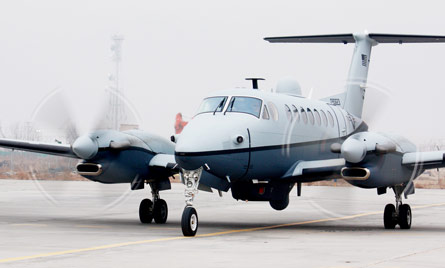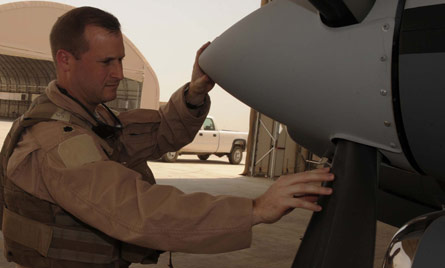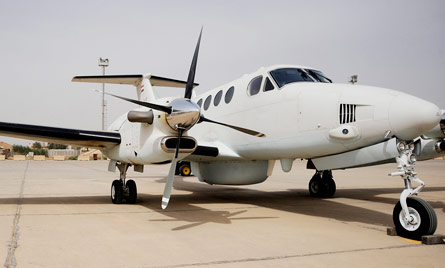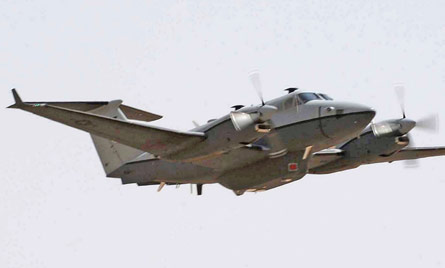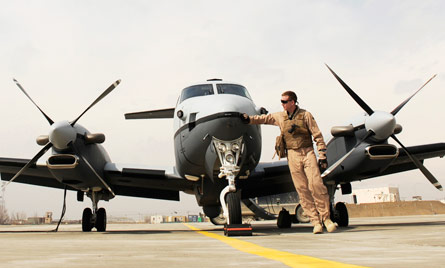Hawker Beechcraft unveiled the King Air 350ER variant at the Paris air show in 2005. It was the latest version of a light turboprop that was introduced in 1964. But the company's expectations for this new version of the venerable King Air were not very high.
"We thought we'd build in the neighbourhood of 40-45 aircraft," Roger Hubble, special mission production manager, said recently.
Five years later, the company is pleased to report the original forecast for the King Air 350ER is grossly in error. With an airframe offering an 8h endurance and a multi-intelligence sensor payload, Hawker Beechcraft inadvertently stumbled on to a new and unexpected market that continues to grow rapidly.
|
|---|
The King Air 350ER has now received orders from a variety of military services and government agencies, including the Iraqi air force, US Air Force and US Customs and Border Patrol. Demand is also high among the intelligence community, which sometimes leases the new type from private operators.
PROJECTIONS OUTPACED
|
|---|
Hubble says it has "built more than 50" King Air 350s, and believes the market, so far, is "nowhere near" satisfied.
The King Air 350ER is discussed as a key platform in the future inventories of the USAF, US Army and US Marine Corps. Moreover, military officials now regard the aircraft as more than an emergency supplement for their overwhelmed fleets of unmanned aircraft.
The aircraft has instead rapidly found a permanent niche in a mission that earlier variants of the King Air, among other light turboprops, pioneered decades ago. As a sensor platform, light utility aircraft and, perhaps soon also a light strike aircraft, the King Air 350ER is likely to fill a key role in the growing field of irregular warfare.
Hawker Beechcraft also hopes the aircraft's military appeal will translate into greater success in the civilian surveillance market. A few commercial operators have already ordered the aircraft, but they are not using it for its intended surveillance mission.
|
|---|
Hawker Beechcraft, however, foresees a new market appearing in the maritime insurance industry - keeping watch over cargo ships in areas swarming with pirate vessels could be attractive with a relatively long-endurance, manned turboprop.
"Insurance companies are the ones that will be letting contracts to companies to fly over major piracy areas to keep track of not just the ships handling cargo, but also any ships that are within 50 miles," Hubble says. "It is not too much of a stretch to see the insurance companies having enough interest to pay companies to surveil certain waterways. Certainly people are talking about it."
To modify the standard King Air 350 for the extended-range mission, Hawker Beechcraft increased the fuel capacity and raised the gross weight. The relatively minor changes to the basic airframe would allow the King Air 350ER to fly non-stop from California to Hawaii - an important stage length for a military aircraft lacking in-flight refuelling capability.
"If you can make that run, you can go anywhere in the world without tanking the airplane," Hubble says.
The fuel capacity in the King Air 350ER grew from 1,640kg (3,600lb) to 2,350kg, by bolting two 450 litre (118USgal) fuel tanks on to the aft end of each engine nacelle. This location was preferable to the only alternative, which involved reusing tip tanks from the Beechcraft B200, Hubble says. The tip tanks added only 380 litres of total useable fuel, and the pods increased the drag on the aircraft.
With over 700kg of extra fuel capacity, the aircraft needed to be certificated at a higher gross weight. "If we didn't do anything with the gross weight you'd just be a flying tanker," Hubble says.
The maximum gross weight for the King Air increased to about 7,480kg from 6,800kg, but the heavier take off weight meant the aircraft could still carry a useful payload.
The change required a new type certificate and several structural modifications. Hawker Beechcraft installed a stronger main landing gear, reusing the wheels, tyres and brakes from the 19-seat 1900D, Hubble says.
The company's engineers also made a slight change to the flight controls. By changing the gearing in the rudder trim tab, the flightcrew would have more authority to move the heavier weight airframe. It was a typically straightforward solution to a problem that could have required designing a new empennage for the King Air 350ER, Hubble says.
The aircraft's Rockwell Collins ProLine 21 avionics software was also adjusted to account for different rotation speeds caused by the aircraft's heavier take-off weight.
Significantly, the King Air 350ER's heavier weight is not matched by an increase in engine power. The same 1,050hp (785kW) Pratt & Whitney Canada PT6A-60A powers both the 350 and 350ER models, and an engine upgrade is not being seriously discussed.
"So far we haven't seen that need," Hubble says, but adds: "If it becomes necessary we can."
But engine power is not considered one of the King Air 350ER's strengths.
"We don't brag about the runway performance," he says. "When you increase gross weight and you don't change the powerplants, the balance field length grows."
To compensate for engine power, King Air 350ER operators taking off on hot days in Iraq and Afghanistan often do so with lighter fuel loads, Hubble says. After the aircraft are ferried into theatre, endurance can often be traded for take-off performance or payload weight.
Hawker Beechcraft had intended to position the extended-range King Air variant as a more affordable alternative to larger maritime patrol aircraft, such as the Alenia Aeronautica ATR 42 and Airbus Military's CN-235. The King Air had previously occupied the top end of a market group that included mostly aircraft with unpressurised cabins, such as the C-212 and PZL Mielec M-28.
PROJECT LIBERTY
|
|---|
Over the next several months, the air force revealed that the programme had selected the King Air platform for an immediate need. Seven used King Air 300s, one used King Air 350 and 23 new King Air 350ERs would be acquired over the next two years, it said, along with sensor equipment and imagery processing systems.
The months preceding the King Air selection had been characterised by sharp disagreements between Secretary of Defense Robert Gates and Schwartz's predecessors in the USAF leadership.
Gates fired former Secretary of the Air Force Michael Wynn and chief of staff Gen Michael Moseley over shortfalls with nuclear security safeguards, by the ISR mission was another area of disagreement between the two sides.
Gates "wanted an ISR system" for deployment to Iraq and Afghanistan, where the existing fleet of UAVs could not meet operational needs.
"The air force was thinking a [Boeing] C-135- and a [Lockheed Martin] C-130[-derivative] four-year, accelerated programme," Hubble says. But Gates "was thinking, no, more like 12 months. That thought process helped the King Air a lot. It got people out of going through a traditional Department of Defense programme."
IRAQ INTRODUCTION
|
|---|
"UAV sensors have come a long way in the last five years," Hubble says. "If they are small enough to fit on a UAV they fit on a King Air pretty well. We can put almost any UAV sensor on a King Air."
The platform has now gained wide acceptance in the private ISR services industry, with several companies offering leased King Airs of all types to intelligence agencies. "The skies over Baghdad are just full of King Airs," Hubble says.
The next major test for the platform is with the US Army. For several years, the service has been seeking to replace its RC-12 Guardrails - B200s adapted for signals intelligence applications - and DHC-7-based RC-7 Airborne Reconnaissance Low platforms with a common fleet. The army cancelled its Aerial Common Sensor contract awarded to Lockheed in 2004 after determining the mission payload exceeded the limits of the selected Embraer ERJ-145.
Meanwhile, it has deployed the enhanced medium-altitude reconnaissance and surveillance system (EMARSS) fleet, which is based on the King Air. The EMARSS is not intended for SIGINT, but the army is widely expected to consider the platform as an at least interim Guardrail replacement.
But Hubble remains sceptical about the King Air's potential as the army's final solution for the ACS requirement.
"I don't know what ACS is doing," he says. "I don't believe what I hear just because people have been saying this for six years now."
But regardless of the US Army's eventual solution for the manned surveillance requirement, Hubble says the company is optimistic about the continued prospects for its King Air 350ER product. "To everyone who thought the King Air was dead four or five years ago it is certainly doing well," he says.
|
|---|
MANNED TURBOPROP VERSUS UAVS – THE ISR DEBATE
THE DAYS of manned turboprop aircraft performing low-altitude surveillance missions were thought to be numbered. The job requires flying long hours within range of small arms fire to track and identify small targets of opportunity. Perhaps no role better suits the term "dull, dirty and dangerous" - a phrase describing the ideal mission for unmanned air systems.
In many ways, the transition from manned surveillance and strike platforms to unmanned aircraft remains the rule. The General Atomics MQ-1 Predator and MQ-9 Reaper compete with the Israel Aerospace Industries Heron 1 and Heron TP for new orders worth billions of dollars every year. Small unmanned systems continue to emerge, with each new generation moving one step closer to a mainstream role.
The sudden rise of the Hawker Beechcraft King Air 350ER - commonly designated the C-12 Huron by the US military - defies the trend. Based on an airframe introduced in the 1960s, the extended-range King Air has unexpectedly stolen a key role for a manned surveillance platform in an historic surge for intelligence, surveillance and reconnaissance platforms.
But the US military's seemingly insatiable appetite for airborne sensor platforms over the past decade has overwhelmed the UAV supplier base. The delivery of new aircraft and - not least - trained pilots and sensor operators has not kept pace with demand.
Unmanned aircraft often provide longer endurance than a manned turboprop, but the operator is "looking at the world through a soda straw", says Roger Hubble, special mission production manager for Hawker Beechcraft. "You can see a very far distance, but you only see tactical things."
For example, medium-altitude unmanned air vehicles often have a 360° synthetic aperture radar mounted on the fuselage belly. Some of these sensors also include a moving target indicator (MTI) mode, which allows the sensor to track anything moving faster than a certain speed.
"The MTI doesn't know what the object is," Hubble says. "It could be a person driving a Toyota truck or an 18-wheeler. All it knows is there's something." The sensor operator can then point the UAV's other sensor, an electro-optical/infrared camera, at the target.
"If you were running the mission and were surveilling the road and saw lots of moving targets on the road you might not think much of it," Hubble says. "But if you saw one that was off the road, you'd say that was a target of opportunity. You'd try to identify what that target is."
The UAV may have a mission requiring a constant orbit in the north-east quadrant of the map, he says. But something else could be happening in the south-west quadrant, or a target of opportunity could move to a different location outside the UAV's area of sensor coverage.
"With manned systems, the pilot can take a strategic view of the battlefield," he says.
The days of manned turboprop aircraft performing low-altitude surveillance missions were thought to be numbered. The job requires flying long hours within range of small arms fire to track and identify small targets of opportunity. Perhaps no role better suits the term "dull, dirty and dangerous" - a phrase describing the ideal mission for unmanned air systems.
In many ways, the transition from manned surveillance and strike platforms to unmanned aircraft remains the rule. The General Atomics MQ-1 Predator and MQ-9 Reaper compete with the Israel Aerospace Industries Heron 1 and Heron TP for new orders worth billions of dollars every year. Small unmanned systems continue to emerge, with each new generation moving one step closer to a mainstream role.
The sudden rise of the Beechcraft King Air 350ER - commonly designated the C-12 Huron by the US military - defies the trend. Based on an airframe introduced in the late 1960s, the extended-range King Air has unexpectedly stolen a key role for a manned surveillance platform in an historic surge for intelligence, surveillance and reconnaissance platforms.
But the US military's seemingly insatiable appetite for airborne sensor platforms over the past decade has overwhelmed the UAV supplier base. The delivery of new aircraft and - not least - trained pilots and sensor operators has not kept pace with demand.
Unmanned aircraft often provide longer endurance than a manned turboprop, but the operator is "looking at the world through a soda straw", says Hubble. "You can see a very far distance, but you only see tactical things."
For example, medium-altitude unmanned air vehicles often have a 360° synthetic aperture radar mounted on the fuselage belly. Some of these sensors also include a moving target indicator (MTI) mode, which allows the sensor to track anything moving faster than a certain speed.
"The MTI doesn't know what the object is," Hubble says. "It could be a person driving a Toyota truck or an 18-wheeler. All it knows is there's something." The sensor operator can then point the UAV's other sensor, an electro-optical/infrared camera, at the target.
"If you were running the mission and were surveilling the road and saw lots of moving targets on the road you might not think much of it," Hubble says. "But if you saw one that was off the road, you'd say that was a target of opportunity. You'd try to identify what that target is."
The UAV may have a mission requiring a constant orbit in the north-east quadrant of the map, he says. But something else could be happening in the south-west quadrant, or a target of opportunity could move to a different location outside the UAV's area of sensor coverage.
"With manned systems, the pilot can take a strategic view of the battlefield," he says.
- Special report on the global ISR aircraft market
Source: Flight International















